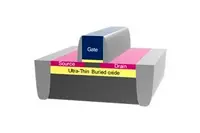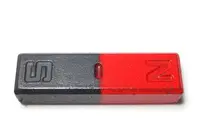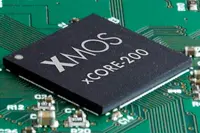Electronics News
Archive : 24 March 2015 год
 Those organisations trying to make fully depleted silicon on insulator (FD-SOI) technology a realistic alternative to FinFETs have sketched out a roadmap intended to broaden its appeal. Included is non volatile memory, better RF handling and a path to 7nm.
Those organisations trying to make fully depleted silicon on insulator (FD-SOI) technology a realistic alternative to FinFETs have sketched out a roadmap intended to broaden its appeal. Included is non volatile memory, better RF handling and a path to 7nm.
At the recent DATE conference in Grenoble, Carlo Reita, director of nanoelectronics technical marketing and strategy with CEA-Leti, said the Institute sees FD-SOI providing a path via 14nm and 10nm nodes to an approach for 7nm that is also likely to be adopted as the follow on to FinFET processes.
"We believe that, at less than 10nm, both planar and FinFET will have to converge on nanowire. The core processes we use for planar can be used for nanowires," Reita claimed.
In common with Intel, which has suggested that the 7nm node and possible successors will need to use III-V semiconductors, Reita said: "We are also starting to include new materials for the nanowires."
"We are working on 14nm with ST and are beginning to concentrate on 10nm FD-SOI. We already have preliminary results that show it's scalable to 10nm," Reita added.
At 10nm, the contacted poly pitch, which determines effective transistor density, will be reduced from 90nm in the 14nm process to 64nm. But the main change will be a reversal of the gate-deposition process, which for 28nm and 14nm, will be gate-first – generally considered to be a cheaper approach to building planar high-k metal-gate structures.
"We will move to gate-last. We expect that it will be a cheaper process than what is being done for other technologies, even when the cost of the substrate is taken into account," Reita claimed.
CEA-Leti also plans to offer monolithic integration as another way of increasing die density using a approach dubbed CoolCube that could potentially integrate combine FinFET with FD-SOI, with each on a different layer. "We are currently working on 28nm and 14nm nodes and collaborating with companies like Qualcomm, IBM and ST. It will be a big breakthrough if we can solve some technology challenges that are still open."
To support MCUs and similar highly embedded designs, CEA-Leti and GlobalFoundries, which has a licence, along with Samsung, to fab FD-SOI products, are developing non volatile memory modules. But this will entail a shift from flash.
Reita explained: "We decided some time ago there was no way to put [charge] trap-storage memories into 28nm. So we are working on resistive RAM and magnetic RAM. We are looking at all three types of resistive RAM before making a final choice."
Gerd Teepe, GlobalFoundries' director of design enablement, said the company's focus is on magnetic RAM for a 28nm compatible non volatile memory.
Although CEA and ST are working on an enhanced RF variant process that will take Fmax to 350GHz, Olivier Thomas, CEA-Leti design centre project leader, said a paper describing a reconfigurable 60GHz power amplifier at the recent ISSCC event showed that high speed RF designs are already feasible using the existing process. "There is a sweet spot for FD-SOI in millimetre wave designs", Thomas claimed.
Design work to further reduce the power consumption of FD-SOI is continuing by exploiting the combination of near threshold operation with dynamic body biasing. Thomas said this will push the viable operating voltage for FD-SOI down to around 0.5V. Experiments with circuits operating down to 0.6V have already demonstrated the ability to support low leakage and then boost performance for gigahertz speeds, although there is today limited automated EDA tool support for the technique.
Author
Chris Edwards
Source: www.newelectronics.co.uk
 Tektronix has unveiled the DPO70000SX, a 70GHz oscilloscope said to feature the lowest noise and highest effective number of bits of any high bandwidth real time oscilloscope currently available.
Tektronix has unveiled the DPO70000SX, a 70GHz oscilloscope said to feature the lowest noise and highest effective number of bits of any high bandwidth real time oscilloscope currently available.
One of the target markets for the device is communications. Dean Miles, technical marketing manager, noted: "We are seeing a lot of investment in optical communications and there is increasing use of microwave frequencies, so there is a need for an instrument with wider bandwidth and higher resolution."
Amongst the device's features are the ability to sample at 200Gsample/s and a compact form factor that allows it to be positioned close to the device under test, retaining signal fidelity.
Tom Freeman, product line marketing manager, added: "Tektronix' asynchronous time interleaving (ATI) technology allows the scope to achieve high bandwidth with low noise." ATI, launched three years ago, allows a signal to be digitised using two symmetrical paths, with each channel accessing the full spectrum.
Engineers can specify one channel at 70GHz or two channels at 33GHz, with a sample rate of 100Gsample/s. Two devices can be synchronised to provide two channels at 70GHz or four channels at 33GHz. Synchronisation is achieved using UltraSync, with a 12.5GHz sample clock reference, a coordinated trigger bus and a high speed data path.
Unusually for such a device, it comes in a 5.25in high package with a small screen. Freeman said: "The small screen helps in set up, but the data captured by the device has more meaning when displayed on an external screen."
Author
Graham Pitcher
Source: www.newelectronics.co.uk
 While attempting to develop a novel type of permanent magnet, a team of researchers at Trinity College Dublin has discovered a new class of magnetic materials based on Mn-Ga alloys.
While attempting to develop a novel type of permanent magnet, a team of researchers at Trinity College Dublin has discovered a new class of magnetic materials based on Mn-Ga alloys.
According to the team, the Mn2RuxGa magnetic alloy – or MRG – has some unusual properties that may allow it to revolutionise data storage, as well as increase wireless data transmission speeds significantly.
The material has no net magnetic moment, but full spin polarisation. No magnetic moment is said to free the material from its own demagnetising forces, as well as being immune to the influence of any external magnetic fields. This property, coupled with full spin polarisation, means the material should be extremely efficient when used in spintronics applications.
A further benefit is its potential to shift the ferromagnetic resonance frequency – the maximum speed at which data is written or retrieved – into the low terahertz range.
The secret was in combining manganese with ruthenium, said researcher Dr Karsten Rode. "Manganese is in the 'Goldilocks zone' – the magnetic coupling of the electrons is neither too strong nor too weak – just right."
"The most difficult part was to understand that our new material was truly special," Dr Rode continued. "Once we realised there was a possibility that we could achieve full compensation of the magnetic moments, coupled with a large spin polarisation, we started checking to see if the 'zero moment half metal' hypothesis would stand intense scrutiny – and it did."
The team now wants to demonstrate spintronic functionality in a practical device. "This is challenging for a manganese based alloy," Dr Rode concluded. "The manganese is easily oxidised and this has to be avoided in a fully-functional thin-film device stack. But now that we think we understand the conditions necessary to create a zero-moment half metal, it is likely that MRG will not long remain an 'only child'."
Author
Graham Pitcher
Source: www.newelectronics.co.uk
 Mentor Graphics has unveiled the Xpedition Package Integrator, a tool which is said to coordinate and optimise the product design process from integrated circuit to PCB.
Mentor Graphics has unveiled the Xpedition Package Integrator, a tool which is said to coordinate and optimise the product design process from integrated circuit to PCB.
Mentor Graphics has unveiled the Xpedition Package Integrator, a tool which is said to coordinate and optimise the product design process from integrated circuit to PCB.
"The Internet of Things and advances in packaging manufacturing technologies mean that there is a need for new design tools and methodologies," said John Park, methodology architect with Mentor's Systems Design Division. "The current approach to package design and board layout is causing bottlenecks and high costs; companies are realising that it will not be possible to design optimal systems without the ability to co-design the IC, package and board."
Xpedition Package Integrator – said to be 'EDA neutral' – supports the design of cross domain systems so that ICs, packages and PCB designs are optimised with each other to reduce package substrate and PCB costs. It provides layer reduction, optimised interconnect paths and streamlined/automated control of the design process. It also offers a formal flow for BGA ball-map planning and optimisation based on an 'intelligent pin' concept, defined by user rules.
In addition, a multi-mode connectivity management system (incorporating hardware description language, spreadsheet and graphical schematic) provides cross domain pin mapping and system level cross domain logical verification.
The Xpedition Package Integrator flow also leverages other Mentor tools, such as HyperLynx and FloTHERM. It can also take advantage of Nimbic, which allows designers to calculate complex electromagnetic fields for chip-package-board simulation.
Author
Neil Tyler
Source: www.newelectronics.co.uk
 XMOS has announced the launch of the XCORE-200, a Gigabit Ethernet enabled family of multicore MCUs. The devices integrate 16 32bit RISC cores and are said to be the first 10/100/1000 Ethernet solutions which offer a programmable MAC layer and webserver support.
XMOS has announced the launch of the XCORE-200, a Gigabit Ethernet enabled family of multicore MCUs. The devices integrate 16 32bit RISC cores and are said to be the first 10/100/1000 Ethernet solutions which offer a programmable MAC layer and webserver support.
Mark Lippett, general manager of the xCORE business unit, said: "This generation of xCORE-200 products can deliver twice the performance of the first generation of xCORE devices and has four times the on chip memory.
"A flexible Gigabit Ethernet port, together with a programmable XMOS USB 2.0 interface and 2Mbyte of flash means these devices are suitable for high performance consumer and professional applications, as well as for emerging IoT applications."
Built on the XCORE-200 XMOS has also unveiled its new xCORE-AUDIO processor family.Delivering bit-perfect audio across a rich set of audiophile and professional interfaces, xCORE-AUDIO processors have been designed to meet the demands of both high-resolution consumer audio and complex multichannel professional audio applications.
There are two product lines: xCORE-AUDIO Hi-Res, targeting the emerging market for stereo high resolution USB headphone amplifiers, DACs and AVR systems and xCORE-AUDIO Live, which supports professional audio applications includingDJ kits, mixing, audio content creation and conferencing.
The first xCORE-AUDIO Live products will appear in April 2015.
Author
Neil Tyler
Source: www.newelectronics.co.uk

